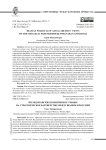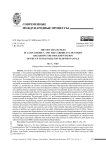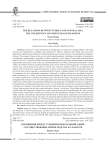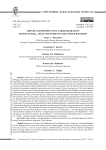Современные международные процессы. Рубрика в журнале - Вестник ВолГУ. Серия: История. Регионоведение. Международные отношения

Iranian Politicians’ and Academics’ Views on the Strategic Partnership Between Iran and Russia
Статья научная
Introduction. Iranian politicians and academics describe the current relations between Iran and Russia in various ways. Research on the nature of the relationship between the two countries has produced conflicting findings and results. This research aimed to explore the perceptions of Iranian politicians and academics regarding the feasibility of forming a strategic partnership between Iran and Russia and to explain the reasons behind their similarities and differences. Methods and materials. Semi-structured, in-depth interviews were conducted using purposive, non-probability sampling among 30 respondents, including politicians and academics, from July to September 2024. The in-depth interviews were coded using an inductive method. Using thematic analysis, these codes were identified based on superficially shared meanings and constant comparison, categorized into themes and sub-themes, and then interpreted. Analysis. Two themes emerged in the interviewees’ perceptions: the first saw a strategic partnership as possible. It was divided into two sub-themes: supporters and opponents of the realization of this partnership so far. The second theme perceived a strategic partnership between the two countries as impossible. It was divided into two sub-themes regarding the feasibility of alternative names for this relationship, such as strategic relations or cooperation. Results. The researcher concluded that the different perceptions within Iran’s political and academic circles stemmed from politicians’ pragmatism and greater sensitivity to Iran’s interests in maintaining good relations with Russia under international sanctions. However, due to their more independent and deeper understanding of empirical evidence and greater distance from policymaking centers, academics of Iran primarily did not consider a strategic partnership with Russia feasible.
Бесплатно

Статья научная
Introduction. The article’s purpose is to identify new challenges in Latin America and the Caribbean (hereinafter – LAC) countries regarding the implementation of the UN Sustainable Development Goals (hereinafter – SDGs). The scientific novelty consists in highlighting the main trends, factors, and signs in the development of LAC countries in the third decade of the 21st century and ways to overcome new challenges of their sustainable development goals. Methods and materials. The messages from news agencies in the USA and Latin American countries were used as materials for the study. Analysis. An analysis of the formal approaches of the United Nations to the process of creating sustainable development was carried out on the basis of foreign sources and literature, including the conditions and possibilities for the implementation of SDGs 1, 2, and 8 by the LAC countries; conceptual differences in the approaches of the United Nations and LAC to the implementation of the SDGs in the context of contemporary turbulence in regional and global politics; and the emergence of new conditions for their cooperation with the leading world powers were identified. Results. The author’s article succeeded in clarifying the possible results from the UN approaches to achieving the Sustainable Development Goals of SDG-2030 in his article. It has been established that LAC countries are unable to fulfill them either on their own or with the help of international organizations. The main goals of SDGs 1, 2, and 8 remain unattainable, both due to the expected decline in economic growth in the period 2026–2029 and the social situation of the population in LAC countries. Past problems of cross-border crime, drug trafficking, extortion, and kidnapping are causing new internal displacement of millions of people. Despite the growing number of prisoners in LAC countries, the problem of crime remains one of the main concerns of Latin American governments. The problem of migration exodus is being resolved very slowly, and its negative impact remains almost at the same level, and in some countries, such as Haiti, Cuba, Colombia, Venezuela, and El Salvador, this problem is growing. In addition, new negative factors have been added, hindering the implementation of the UN SDGs. These are negative environmental and climatic factors in Latin America, the American policy of mass deportations of Latin Americans from the USA, which creates additional pressure among the most vulnerable segments of the population, and the American tariff policy in the Latin American region. At the same time, a “window of opportunity” is opening for LAC countries to enter the world stage to expand their cooperation with countries from other continents in Africa and Eurasia, both directly and within the framework of BRICS and the Chinese Belt and Road Initiative.
Бесплатно

The Relations Between Turkey and Central Asia: The Coexistence of Strength and Weakness
Статья научная
Introduction. Turkey has become an integral part of Central Asia’s foreign relations. The article examines the characteristics, strengths, and weaknesses of Turkey’s relations with Central Asia across three dimensions: historical and cultural ties, bilateral political and economic relations, and multilateral cooperation. Methods. The research is based on the use of a mixed-method approach, including a combination of quantitative and qualitative methodologies, integration of history and policy, and a merger of case studies and comparative analysis. Materials. The article is based on factual material extracted from the latest statistical data of international organizations and countries under study, the scientific publications of scholars, and media commentaries. Current studies on Turkish-Central Asia relations primarily focus on Pan-Turkism, the foreign policy of Turkey towards Central Asia, and the great power game in Central Asia, with less attention paid to the considerations and choices of the Central Asian countries themselves. Analysis. The historical and cultural connections, based on the Turkic factor, can be regarded as an important bond in Turkey’s regional relations with Central Asia, laying the foundation for their educational cooperation. Influenced by political mutual trust, presidential transition, trade construction, etc., Turkey’s political and economic relations with the Central Asian countries have obvious by-country characteristics. In trade and economic terms, links between Turkey and Central Asian countries have strengthened but remain at a low level. The Organization of Turkic States plays a prominent role in multilateral cooperation, making efforts in partnership building, the implementation of the Middle Corridor, the expansion of the organization, and language Latinization. Results. It is concluded that Central Asian countries have differences with Turkey over interests, which leads to the fact that Turkey has unique advantages in developing relations with Central Asian countries but also faces some bottlenecks. Authors’ contribution. Yuyan Zhang conceptualized the research topic and elaborately designed the overall research framework and methodology. She also wrote the majority of the original draft, covering key sections such as the introduction, literature review, and results. Keyi Xiang collected, systematized, and analyzed statistical data of international organizations and countries under study during the research.
Бесплатно

Trends and Prospects of Labor Migration from Central Asian Countries to the United Kingdom
Статья научная
Introduction. Among European countries, the UK is experiencing one of the most acute labor shortages, especially in labor-intensive and low-prestige sectors such as agriculture. Following Brexit, the UK was compelled to expand the geography of labor recruitment beyond the traditional pool of Eastern European seasonal workers (Poland, the Baltics, Bulgaria, and Ukraine) to include Central Asian countries. This article aims to identify the trends and prospects of labor emigration from Central Asian countries to the UK within the context of growing political and economic competition among key actors in the region. Methods and materials. The study combines analytical, statistical, and sociological approaches. It draws on World Bank and IOM datasets on labor migration and remittances, complemented by thematic content analysis of Russian and British media and expert interviews. Official documents from government agencies, embassies, recruitment agencies, and migrant training centers are also examined. Analysis. The analysis covers the scale, drivers, and channels of emigration from Central Asia to the UK, the participation of Central Asian workers in the British labor market, and the prospects for seasonal migration. Results. The results show that labor shortages in the UK labor market are the primary driver of migration from Central Asia. The reorientation of migration flows from the Russian direction is explained by the economic downturn in Russia, the tightening of migration legislation and the spread of English among young people in Central Asian countries. Since 2021, there has been an increase in seasonal migration of low-skilled workers, primarily through public and private recruitment agencies. Authors’ contribution. S.V. Ryazantsev – research concept and economic analysis of labor migration; K.P. Kurylev – political aspects and international relations; A.Kh. Rakhmonov – social consequences and interview analysis; K.Kh. Rakhimov – historical context and geopolitical factors of migration; A.L. Chupin – statistical analysis and policy recommendations on migration.
Бесплатно

